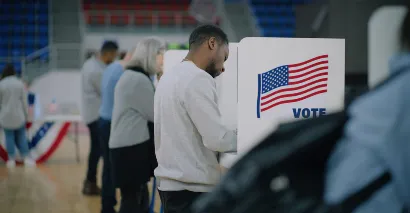Key Highlights
The United States Citizenship and Immigration Services (USCIS) has enhanced its SAVE (Systematic Alien Verification for Entitlement) in order to enhance the processes of voter verification by states.
The given update is significant as it enables the election officials to confirm citizenship with the assistance of the last four digits of the Social Security numbers (SSNs), as well as names and dates of birth, instead of full SSNs. The reform is expected to ease and expedite the process of verifying voter citizenship to ensure that states have an accurate voter registration list and that noncitizens do not vote.
Background of the SAVE Program
The SAVE program was initially used to help states and federal agencies in checking the immigration or citizenship status as a condition to receive benefits. Its application has, over time, been broadened to aid in the assurance of only the eligible U.S citizenship being registered to vote in the federal elections.
The new 2025 changes are the concerns of the federal government to ensure election integrity based on the federal laws of protecting election integrity through the signing of the earlier Executive Order 14248, which requires a time-consuming citizenship verification to register voters.
Key Features of the 2025 Upgrade
-
Partial SSN Use: States are now allowed to use only the final four digits of SSNs together with names and dates of birth without having to use all nine digits of SSNs.
-
Bulk Data Uploads: Election agencies are able to conduct bulk verifications, which is faster to do than in the past, where one had to query the voter list one-at-a-time.
-
Fee Removal: USCIS has eliminated fees for government agencies utilising SAVE to verify voters to promote its use.
-
High Query Rates: The federal and state agencies have conducted over 205 million verification checks nationwide by October 2025, which highlights the importance of the system.
Also Read: UK Visitor Visa: Complete Application and Guidelines
Impact on Voting and Election Officials
The upgrade helps the states to identify possible noncitizens or mismatches in the voter lists quickly. Nevertheless, the USCIS also stresses the fact that flagged cases should be followed up by state election officials, who should investigate the facts, grant a chance to prove their citizenship to voters, and renew voter registration when necessary. This stratified method will not violate the rights of voters and prevent false disfranchisement.
|
Verification Type |
Number of Queries (in millions) |
|
State Voter Verification |
46 |
|
Federal Benefits Checks |
110 |
|
Total Queries (Jan-Oct) |
205 |
Ongoing Debate and Oversight
Although such a system intends to deter the infrequent cases of noncitizen voting, advocacy groups fear the chances of wrongful removals of qualified voters because of inaccuracies in data. The dependency of SAVE on the Social Security Administration data is not exhaustive of the citizenship data, especially for older or naturalised citizens.
Therefore, extensive protection and open election office practices are essential to strike a balance between the safety of the election and the fairness of voter access.
Also Read: Great Opportunities with UK Work Visa for Indians
Conclusion
The upgrade of the USCIS voter verification system in 2025 is a major move toward the protection of elections by means of efficient and partial-SSN-based citizenship verification via the SAVE program. This improvement assists the states in having the correct voter roll and deals with the issue of voter fraud with an added focus on safeguarding against wrongful disenfranchisement of the voters.
Election officials must continue following thorough verification procedures to ensure every eligible voter retains their rightful voice. For authoritative reference and interlinking, use the official U.S. Citizenship and Immigration Services website. To know more about the USCIS election, visit TerraTern now!








